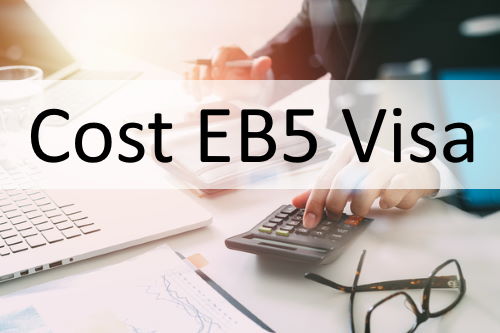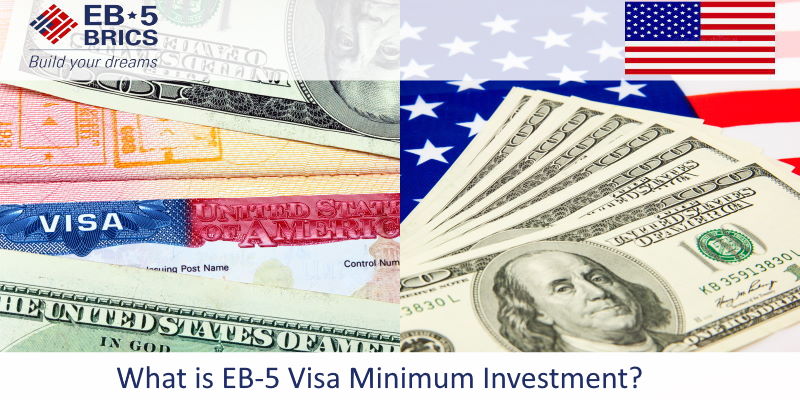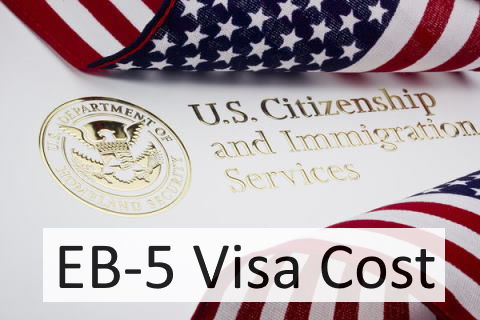The cost of the EB-5 visa includes a minimum investment amount of either $1.05 million or $800,000 (in a TEA), administrative costs for the investor visa, an I-526 petition filing fee of approximately $3,675, application fees for the I-485 of $1,140, an I-829 fee of $3,750, and typical lawyer’s charges. In addition, the EB-5 visa offers a pathway to obtaining a USA residency Green Card and U.S. citizenship.
A Targeted Employment Area (TEA) is defined as:
TEA direct investment projects are available. Contact us today for more information.

An EB-5 investment is one part of the steps that an immigrant investor takes to become a permanent resident of the United States. The EB-5 visa requires a minimum investment of $1.05 million or $800,000 in a Targeted Employment Area (TEA). Investors must invest the required amount in a business in the United States and aim to create or sustain 10 full-time, permanent jobs for qualified Americans. EB5 States possesses the expertise to guide you towards citizenship through investment and has successfully assisted numerous families in navigating the landscape of EB-5 visa costs.

In 2023, a minimum investment of $800,000 in a Targeted Employment Area (TEA) is necessary, either through a USA Regional Center project or by directly investing in a new business.
The EB-5 visa cost comprises the EB5 investment amount, regional center administrative costs (if applicable), petition filing, application, and attorney fees. The actual cost depends on factors such as the type of investment and the experience and reputation of the chosen attorney if the investor opts to use one.
The Regional Center charges the EB-5 Visa Administration Fees to manage the project. These fees depend on the chosen regional center and project, typically ranging from $50,000 to $70,000. According to the annual report by the U.S. Department of State, approximately 96% of investors opt to invest through a Regional Center rather than through direct investment.
The EB-5 Visa petition filing fee for the I-526 application is $3,675. This fee is paid to file Form I-526, which is necessary to proceed and obtain a conditional green card from the United States Citizenship and Immigration Services (USCIS).
The processing fee for the EB-5 Visa application to file Form I-485, which is for Adjustment of Status to Obtain a US Green Card, is $1,140.
The visa cost for an I-829 application is $3,750. In addition, the I-829 petition includes evidence that the immigrant investor has successfully met all requirements set by the United States Citizenship and Immigration Services (USCIS).
The legal fees for an EB-5 Visa Immigration Attorney include the costs of filing all necessary paperwork, such as preparing the I-526 Immigrant Petition and the I-485 Adjustment of Status and removing conditions after two years. Legal costs for an EB-5 Visa Immigration Attorney typically range from $15,000 to $25,000, depending on the law firm you hire.
The required documents to prove the source of funds for an EB-5 investment are essential to the Form I-526 petition. These documents demonstrate that the funds were obtained legally and should clearly illustrate the flow of funds from their source to the point of investment.
The EB-5 Source of Funds Requirements outline the various types of funds:
By submitting these required documents, an investor can substantiate the lawful source of their funds for an EB-5 investment.
EB-5 investors receive their money back if the borrower/developer successfully develops and executes the development project in which the EB-5 investor has invested in an EB-5 USA regional center.
Yes, an EB-5 investor can obtain a loan to make an EB-5 investment more affordable. Loan proceeds are an acceptable form of capital for an EB-5 investment, provided that the EB-5 investor is the loan’s primary borrower and is personally liable for repayment. Additionally, the loan must be secured by the investor’s assets.
No, an EB-5 investor doesn’t need to open a U.S. bank account. EB-5 investors often encounter difficulties opening a U.S. bank account without a physical address or a social security number. Instead, funds can be directly transferred to the escrow account of the EB-5 project in which the investor is investing. An EB-5 Escrow Account serves as a third-party entity, acting as the escrow agent, to receive, hold, and disburse the funds based on mutually agreed-upon release conditions between the investor and the EB-5 Regional Center.
An EB-5 Escrow Account is a third-party entity, known as the escrow agent, responsible for receiving, holding, and subsequently disbursing funds based on mutually agreed-upon release conditions between the investor and the EB-5 Regional Center.
Yes, you can use a bank loan to apply for an EB-5 visa, but strict conditions must be met:
Major Banks, as well as local and foreign ones, offer loans and banking services to EB-5 regional centers, project developers, fund managers, and foreign investors.
Yes, an EB-5 investor is subject to paying taxes. Prior to obtaining conditional permanent resident status in the U.S., EB-5 investors who receive distributions from a project in a Regional Center or as a result of their investment in a new commercial enterprise are typically subject to withholding tax (if they are in the United States in another lawful immigration status). Depending on the substantial presence requirement, they may be subject to U.S. income tax if they are present in the country. Once granted conditional permanent residency in the U.S., EB-5 investors are subject to federal income tax on worldwide income. This includes both domestic and international sources of revenue. However, if the U.S. and the investor’s home country have an income tax treaty, a foreign tax credit may be granted for income taxed outside of the U.S. Note that certain countries do not have income tax treaties with the U.S. In addition to income taxes, EB-5 investors are also responsible for paying gift, estate, state, and generation-skipping transfer taxes.
The factors affecting EB-5 visa costs include all the fees associated with obtaining this investor-based visa. These costs may include:
The largest component of EB-5 visa costs is the EB-5 investment itself. The amount required to be eligible for an EB-5 visa is known as the EB-5 investment. Currently, a minimum investment of $1.05 million is required. However, if the investment is made in a targeted employment area (TEA) or in a regional center-associated infrastructure project, the investment cost is reduced to $800,000. A TEA is defined as a region with a high unemployment rate or a rural area.
The percentage of EB-5 visa attorney costs in the total EB-5 investment visa cost can vary depending on the attorney and the type of investment being made. Providing legal guidance for a direct EB-5 investment requires more time and work compared to a regional center investment. The typical range for attorney fees is between $15,000 and $30,000, depending on the complexity of the work and the experience of the EB-5 visa attorney.
Yes, the EB-5 visa does provide a pathway to U.S. citizenship. Investors are eligible to apply for citizenship after five years of having “unconditional residency” status, which is obtained through the 10-year Green Card, and meeting other naturalization requirements. In total, an individual must reside in the U.S. for at least seven years before applying for citizenship.
Yes, it is necessary to renew the EB-5 visa six months before its expiration. However, if you have obtained an EB-5 visa with a validity period of ten years, you do not need to reapply for a visa. Instead, you simply need to renew your existing EB-5 visa before it expires.
An EB-5 visa is valid for ten years. It grants the investor, their spouse, and their unmarried children under the age of 21 a 10-year Green Card, which is renewable. EB-5 visa holders have the right to permanently stay and work in the United States. After their initial conditional residency, they may apply for naturalization and receive all the rights and benefits associated with U.S. citizenship after five years.
The worthiness of the EB-5 visa depends on an individual’s circumstances and personal considerations. It is a highly personal decision. The key factor is that the EB-5 visa provides the fastest route to U.S. citizenship. The value of this opportunity varies from person to person. The EB-5 visa program offers time savings and the chance to invest in the U.S. The returns on investment may vary depending on the safety and profitability of the investment. However, the true value lies in obtaining American citizenship. The cost of the EB-5 visa is an investment in one’s future in the USA.
Please note that all fees and EB-5 investment amounts mentioned above are in U.S. dollars.

EB5 States is here to help guide you to citizenship through an investment or the Golden Visa. As consultants, we have successfully assisted many families in navigating the EB-5 immigration landscape, particularly the issues surrounding the EB-5 investment amount.
Contact us to schedule a One-on-One Meeting with Vivek Tandon, Esq., a U.S. Lawyer and Investment Banker.
See All USA Investment Visa
EB-5 investors can expect to receive their money back if the borrower/developer successfully develops and executes the development project in which the EB-5 investor has invested through an EB-5 USA regional center. See processing times for countries.
Yes, an EB-5 investor can take a loan to make an EB-5 investment, provided that they meet certain USCIS requirements. See more EB-5 information.
Yes, EB-5 can certainly work for you as long as you meet the two major requirements of EB-5: first, the investment must be at risk,’ and second, the investment must create ten new full-time jobs in the U.S. economy. EB5 States
On average, investments that tend to be more secure offer a rate of return ranging from 1% to 3%.
To establish the legitimacy of the EB-5 investment amount, you will need the required documents to prove the source of funds. The source of funds, i.e., how the invested money was earned or accumulated, must be thoroughly and convincingly documented and presented. An investor should submit as many types of documentary evidence as possible relating to the source of funds for both the investor and their spouse and any additional sources such as banks and relatives if the funds were obtained through a loan or gift.
While it is not necessary, it is preferred for an investor to open a U.S. bank account to facilitate the transfer of funds. After that, the funds are transferred into an EB-5 Escrow Account, which is a third party (the escrow agent) that receives, holds, and disburses the money upon the satisfaction of mutually agreed-upon release conditions between the investor and the EB-5 issuer.
US Programs
European programs
Email : info@EB5States.com
Copyright © 2022 EB5 States | All Rights Reserved